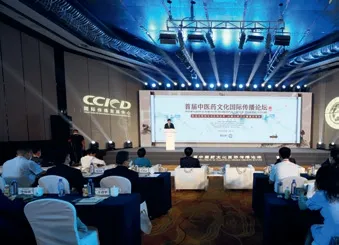Nature’s Remedy Traditional Chinese medicine contributes to global public health governance
2022-07-14ByLiQing
By Li Qing
, or, is a traditional Chinese medicine (TCM) classic compiled by Chinese pharmacologist and physician Zhang Zhongjing in the late Han Dynasty (202 B.C.-A.D. 220). The work is amongst the oldest complete medical textbooks in the world and is considered one of the four canonical works of TCM.
The book focuses on treating infectious diseases and internal diseases. It inspired the development of the Lung Cleansing and Detoxifying Decoction formula. With no fewer than 21 herbal components,this recipe is effective against fever, cough and fatigue, as well as helps clear the lungs. It has shown definite therapeutic effects on COVID-19 patients.
Humans have fought against diseases throughout history. “TCM protects the health of the Chinese people and bears unique Chinese characteristics,” Du Zhanyuan, President of China International Communications Group (CICG), said at the International Forum on Traditional Chinese Medicine Culture in Beijing on July 5. “It’s China’s contribution to the health of humanity,” he added.

Du Zhanyuan, President of China International Communications Group, delivers a speech at the International Forum on Traditional Chinese Medicine Culture in Beijing on July 5
On the frontlines
TCM has thousands of years of experience in fighting different epidemics and has over time contributed many effective treatments and drugs, Zhang Boli, an academician with the Chinese Academy of Engineering and President of the Tianjin University of Traditional Chinese Medicine, said at the forum.
“Facing COVID-19, TCM has served different areas across China and played a critical role in prevention, treatment and rehabilitation where there were no targeted remedies available,” he added
Since early 2020, when it was used in Wuhan,Hubei Province, TCM has had an excellent clinical track record in fighting COVID-19. In February,Chinese authorities officially recognized three finished medicines and three herbal formulas,including the Lung Cleansing and Detoxifying Decoction, as effective medications and recommended these to the public.
He also suggested that by giving full play to the advantage of prevention,TCM can follow in the footsteps of vaccines and create another line of defense,especially for high risk groups.
Traditional treatment emphasizes each patient’s individual physical characteristics and adheres to personalized diagnosis and therapy. In addition, the integration of TCM and Western medication increases the cure rate and reduces the risk of death.
For example, mechanical respiratory and circulatory support is at times crucial to saving lives. TCM can help solve any adverse reactions following these types of medical interventions and, at the same time, improve the blood’s oxygen saturation levels—subsequently protecting organs.
TCM practitioners have gained priceless experience during the battle against COVID-19 and shared it with the world, Zhang said.
And the world has welcomed their know-how.
According to a report unveiled by the World Health Organization (WHO)in March, the early application of TCM may result in better clinical outcomes for patients with mild-to-moderate COVID-19, reducing the risk of progression.When administered as add-on interventions to conventional treatment, it may shorten the time for viral clearance and length of hospital stay, and facilitate resolution of clinical symptoms, compared with conventional ones alone.
“The report proves that TCM has stood the test of time and remains effective in the prevention and treatment of emerging infectious diseases,benefiting global public health,” Yu Wenming,Commissioner of the National Administration of Traditional Chinese Medicine, said at the forum.
As of late 2021, China has released a multilingual version of the TCM treatment plan for COVID-19, helping over 150 countries and regions.Related products have been distributed to more than 10 countries and regions in need, and experts have visited 28 countries and regions to help locals with pandemic prevention and control efforts.
Going global
In March, the Chinese Government issued a new five-year plan for TCM development, introducing comprehensive arrangements for related undertakings. The blueprint aims to enhance the capacity of health services, TCM inheritance, protection and innovation, and encourages a combination of Chinese and Western medicine.
The document also proposes acceleration of the promotion of TCM by integrating it into the Belt and Road Initiative, implementing international cooperation and upgrading the construction of overseas Chinese medical centers and international operation bases.
During the 14th Five-Year Plan (2021-25) period, we should also advance exchanges between TCM agencies and other social forces, such as companies and organizations engaged in research and development, Yu said.
TCM is now available in 196 countries and regions with 30 TCM centers abroad and 56 international cooperation centers serving people worldwide. The private sector has also participated in the introduction of TCM to the world. For example, Tong Ren Tang, a TCM brand with 350 years’ history, operates about 140 retail stores in 28 countries and regions to treat patients.
According to a report on China’s image in 2020, conducted by the Center for International Communication Studies under CICG, about 30 percent of overseas respondents had had experience with TCM, of whom more than 80 percent evaluated it as positive.
Acupuncture is a classic and star TCM product in the global market. In April,magazine released an article titled Why Acupuncture Is Going Mainstream in Medicine. “A blend of anecdotal success, research-backed results, and a growing level of openness from the medical community are all driving the popularity of acupuncture as a therapy,” it read.
According to a 2021 WHO report, acupuncture is becoming more and more popular in the U.S. In 2020, the Centers for Medicare & Medicaid Services even began covering acupuncture for the first time for the treatment of chronic lower-back pain. “Acupuncture has been used for centuries.Only in the past decade has there been a seismic shift in acceptance by both Western doctors and patients,” the article further stated.
As an important part of TCM, acupuncture has been applied in 193 countries and regions, making it the most widely used traditional medicine in the world, President Liu Baoyan of the World Federation of Acupuncture-Moxibustion Societies,a nongovernmental organization, said at the forum.
“It creates a channel for the world to understand TCM culture and Oriental philosophy,” he added.
TCM reveals the law of human health and disease from a macroscopic, systematic and holistic perspective. “It’s a symbol of Chinese culture as an inseparable chapter in the nation’s history, customs and diet,” Du said, adding that CICG will expand its domestic and international cooperation to enhance the brand recognition of TCM in the future.
“We must strengthen the research on the international communication of TCM culture like, a core TCM component that focuses on the prevention of illness and the nourishing of the body,” Yu suggested.
He also stressed decoding the culture in an open fashion during international exchanges so that non-practitioners can more easily gain an understanding of its functions, value and cultural connotations. BR
